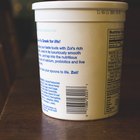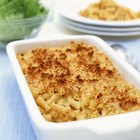
Greek or Balkan-style yogurt is noticeably thicker than most varieties sold in America, with less whey and a generally stiffer texture. Like other forms of yogurt it tends to curdle or "break" when it's cooked, separating into liquid whey and small, firm curds of protein. Yet, Greek and Middle Eastern dishes commonly feature cooked sauces containing yogurt. The key to this apparent paradox lies in careful preparation.
About Yogurt
Yogurt is caused by the activity of several families of related bacteria, most importantly a variety of lactobacillus called L. bulgaricus, and a streptococcus bacteria called S. thermophilus. When milk is kept at a warm temperature of 104 F to 113 F, these bacteria reproduce rapidly and make it acidic. The acidity in turn acts to coagulate the proteins in the milk, setting them into a soft gel. Traditionally the milk was boiled first, both to kill undesirable bacteria and to concentrate its proteins, making a thicker yogurt. Today, thick Greek-style yogurt usually has milk powder added, to achieve the same effect.
The Effect of Heat
When yogurt is heated gently, little happens at first. However, as its temperature rises, its strands of protein begin to shrink and tighten in on themselves. The texture of your yogurt was caused by those protein strands immobilizing the milk's water molecules; as they contract in the heat the whey begins to squeeze out. As the whey separates, the proteins clump together and form small, firm curds. Greek-style yogurt is especially prone to this, because of the concentrated milk proteins that give it its firmness.
Cooking with Yogurt
Yogurt-making provides a valuable method for preserving perishable milk in hot climates, but its versatility is sharply limited if it can't be used in cooked dishes. Unsurprisingly, cooks in Greece and other countries have found ways to use yogurt in hot dishes, without having it break and separate. The trick is to stabilize the yogurt by adding a thickener, which holds the whey in suspension. The two most commonly used alternatives are cornstarch and egg yolks.
Stabilizing the Yogurt
For each quart of Greek-style yogurt, you'll need either one egg white or 1 tablespoon of cornstarch. If you're using cornstarch, mix it first with 3 tablespoons of water to make a paste. Beat the yogurt thoroughly until it has softened to a smooth, liquid texture. Whisk in the beaten egg white or cornstarch paste, then heat the yogurt gently until it just barely boils. Turn the heat down to minimum and let it barely simmer for 10 minutes, stirring occasionally. At that point, the yogurt will be stabilized and ready to use in your favorite recipes.
Related Articles

Cooking Yogurt Without Curdling It

What Happens When You Heat Up Greek ...

How to Mix Yogurt With Unflavored ...

Cooking Yogurt Without Curdling It

Low Fat Substitute for Mascarpone

Does Lime Make Sour Cream Curdle?

How to Freeze Greek Yogurt

What Is Balkan Yogurt?

What Are the Functions of Pectin in ...

Why Does a Sauce Curdle?

The Amount of Lactose in Yogurt

Why Does Milk Curdle When Baking a ...
How to Save Homemade Yogurt That Didn't ...

Why Does Greek Yogurt Have More Protein ...

What Can Be Used as a Substitute for ...

Does Cooking With Yogurt vs. Sour Cream ...

Substitute for Heavy Whipping Cream in ...

How to Keep Custard Sauce From Curdling

Why Does Milk Curdle When it Is Mixed ...

Kefir Substitute
References
- "On Food and Cooking: The Science and Lore of the Kitchen"; Harold McGee; 2004
- "A New Book of Middle Eastern Food"; Claudia Roden; 1985
- Recipe Tips: Yogurt
- Clifford A. Wright.com; How to Prepare Yogurt for Cooking; Clifford A. Wright
Writer Bio
Fred Decker is a trained chef and prolific freelance writer. In previous careers, he sold insurance and mutual funds, and was a longtime retailer. He was educated at Memorial University of Newfoundland and the Northern Alberta Institute of Technology. His articles have appeared on numerous home and garden sites including GoneOutdoors, TheNest and eHow.
Photo Credits
Goodshoot/Goodshoot/Getty Images